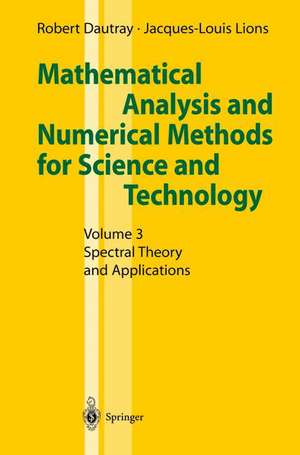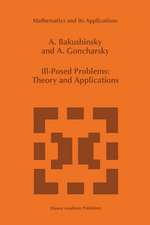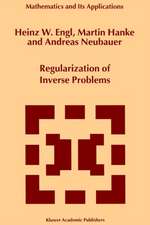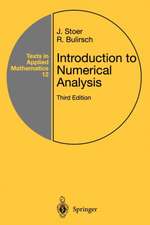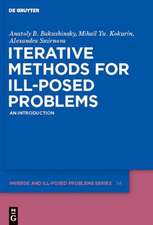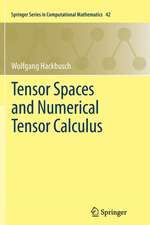Mathematical Analysis and Numerical Methods for Science and Technology: Volume 3 Spectral Theory and Applications
Autor Robert Dautray Contribuţii de M. Artola Traducere de J.C. Amson Contribuţii de M. Cessenat Autor Jacques Louis Lionsen Limba Engleză Paperback – 22 noi 1999
| Toate formatele și edițiile | Preț | Express |
|---|---|---|
| Paperback (6) | 471.93 lei 38-44 zile | |
| Springer Berlin, Heidelberg – 22 noi 1999 | 471.93 lei 38-44 zile | |
| Springer Berlin, Heidelberg – 22 noi 1999 | 471.98 lei 38-44 zile | |
| Springer Berlin, Heidelberg – 22 noi 1999 | 476.18 lei 38-44 zile | |
| Springer Berlin, Heidelberg – 22 noi 1999 | 480.71 lei 38-44 zile | |
| Springer Berlin, Heidelberg – 22 noi 1999 | 487.73 lei 38-44 zile | |
| Springer Berlin, Heidelberg – 22 noi 1999 | 494.18 lei 38-44 zile |
Preț: 476.18 lei
Preț vechi: 595.22 lei
-20% Nou
Puncte Express: 714
Preț estimativ în valută:
91.15€ • 99.04$ • 76.61£
91.15€ • 99.04$ • 76.61£
Carte tipărită la comandă
Livrare economică 16-22 aprilie
Preluare comenzi: 021 569.72.76
Specificații
ISBN-13: 9783540660996
ISBN-10: 3540660992
Pagini: 552
Ilustrații: 1
Dimensiuni: 155 x 235 x 29 mm
Greutate: 0.77 kg
Ediția:2000
Editura: Springer Berlin, Heidelberg
Colecția Springer
Locul publicării:Berlin, Heidelberg, Germany
ISBN-10: 3540660992
Pagini: 552
Ilustrații: 1
Dimensiuni: 155 x 235 x 29 mm
Greutate: 0.77 kg
Ediția:2000
Editura: Springer Berlin, Heidelberg
Colecția Springer
Locul publicării:Berlin, Heidelberg, Germany
Public țintă
ResearchDescriere
The
advent
of
high-speed
computers
has
made
it
possible
for
the
first
time
to
calculate
values
from
models
accurately
and
rapidly.
Researchers
and
engineers
thus
have
a
crucial
means
of
using
numerical
results
to
modify
and
adapt
arguments
and
experiments
along
the
way.
Every
facet
of
technical
and
industrial
activity
has
been
affected
by
these
developments.
The
objective
of
the
present
work
is
to
compile
the
mathematical
knowledge
required
by
researchers
in
mechanics,
physics,
engineering,
chemistry
and
other
branches
of
application
of
mathematics
for
the
theoretical
and
numerical
resolution
of
physical
models
on
computers.
Since
the
publication
in
1924
of
the
"Methoden
der
mathematischen
Physik"
by
Courant
and
Hilbert,
there
has
been
no
other
comprehensive
and
up-to-date
publication
presenting
the
mathematical
tools
needed
in
applications
of
mathematics
in
directly
implementable
form.
Cuprins
VIII.
Spectral
Theory.-
§1.
Elements
of
Spectral
Theory
in
a
Banach
Space.
Dunford
Integral
and
Functional
Calculus.-
1.
Resolvant
Set
and
Resolvant
Operator.
Spectrum
of
A.-
2.
Resolvant
Equation
and
Spectral
Radius.-
3.
Dunford
Integral
and
Operational
Calculus.-
4.
Isolated
Singularities
of
the
Resolvant.-
§2.
Spectral
Decomposition
of
Self-Adjoint
and
Compact
Normal
Operators
in
a
Separable
Hilbert
Space
and
Applications.-
1.
Hilbert
Sums.-
2.
Spectral
Decomposition
of
a
Compact
Self-Adjoint
Operator.-
3.
Spectral
Decomposition
of
a
Compact
Normal
Operator.-
4.
Solution
of
the
Equations
Au
=
f.
Fredholm
Alternative.-
5.
Examples
of
Applications.-
6.
Spectral
Decomposition
of
an
Unbounded
Self-Adjoint
Operator
with
Compact
Inverse.-
7.
Sturm-Liouville
Problems
and
Applications.-
8.
Application
to
the
Spectrum
of
the
Laplacian
in
???n.-
9.
Determining
the
Eigenvalues
of
a
Self-Adjoint
Operator
with
Compact
Inverse.
Min-Max
and
Courant-Fisher
Formulas.-
§3.
Spectral
Decomposition
of
a
Bounded
or
Unbounded
Self-Adjoint
Operator.-
1.
Spectral
Family
and
Resolution
of
the
Identity.
Properties.-
2.
Spectral
Family
Associated
with
a
Self-Adjoint
Operator;
Spectral
Theorem.-
3.
Properties
of
the
Spectrum
of
a
Self-Adjoint
Operator.
Multiplicity.
Examples.-
4.
Functions
of
a
Self-Adjoint
Operator.-
5.
Operators
which
Commute
with
A
and
Functions
of
A.-
6.
Fractional
Powers
of
a
Strictly
Positive
Self-Adjoint
Operator.-
§
4.
Hubert
Sum
and
Hilbert
Integral
Associated
with
the
Spectral
Decomposition
of
a
Self-Adjoint
Operator
A
in
a
Separable
Hilbert
Space
H*.-
1.
Canonical
Representation
Associated
with
a
Self-Adjoint
Operator
Whose
Spectrum
is
Simple.-
2.
Hilbert
Sum
Associated
with
the
Spectral
Decomposition
of
a
Self-Adjoint
Operator
A
in
a
Separable
(and
Complex)
Hilbert
Space
H.-
3.
Hilbert
Integral.
Diagonalisation
Theorem
of
J.
von
Neumann
and
J.
Dixmier.-
4.
An
Application:
The
Intermediate
Derivative
and
Trace
Theorems.-
5.
Generalised
Eigenvectors.-
Appendix.
“Krein-Rutman
Theorem”*.-
IX.
Examples
in
Electromagnetism
and
Quantum
Physics*.-
A.
Examples
in
Electromagnetism.-
§1.
Basic
Tools:
Gradient,
Divergence
and
Curl
Operators.-
1.
Introduction.
Definitions
(Gradient,
Divergence,
Curl).-
2.
The
Spaces
H
(div,
?)
and
H
(curl,
?).
Principal
Properties.-
3.
Kernel
and
Image
of
the
Gradient,
Divergence
and
Curl
Operators.
Introduction.-
4.
Some
Results
on
Regularity.-
§2.
Static
Electromagnetism.-
1.
Magnetostatics
of
a
Surface
Current.-
2.
Electrostatics
of
a
Surface
Charge.-
Review
of
§
2.-
§3.
The
Spectral
Problem
in
a
Bounded
Open
Domain
(Cavity)
with
Perfect
Conductor
Boundary
Conditions.-
1.
Definition
and
Fundamental
Properties
of
the
Maxwell
Operator
A
in
an
Open
Domain
?
??3
with
Bounded
Boundary
?
=
??.-
2.
Spectral
Properties
of
A
in
a
Bounded
Open
Domain
(Cavity).-
Review
of
§
3.-
§4.
Spectral
Problems
in
a
Wave
Guide
(Cylinder).-
1.
Introduction.-
2.
The
Maxwell
Operator
A
in
a
Cylinder.
Definition
of
D
(A)
and
the
Trace
Theorem.-
3.
Study
of
the
Kernel
of
the
Operator
A
in
the
Space
H.-
4.
Spectral
Decomposition
of
the
Maxwell
Operator
A
in
the
Case
of
a
Cylinder
(“Wave
Guide”)
?
=
?T
×
?
with
?T
a
Connected
and
Regular,
Bounded
Open
Domain
in
?2.-
Spaces
Utilised.-
B.
Examples
in
Quantum
Physics.-
on
the
Observables
of
Quantum
Physics.-
§1.
Operators
Corresponding
to
the
Position,
Momentum
and
Angular
Momentum
Observables.-
1.
System
Consisting
of
a
Single
“Non
Relativistic”
Particle
Without
Spin,
Located
in
the
Space
?3.-
2.
System
Consisting
of
a
Single
“Non
Relativistic”
Particle
with
Spin
(1/2)
in
?3.-
3.
System
of
a
Single
Particle
Located
in
a
Bounded
Domain
???3.-
4.
System
of
N
Distinguishable
non
Relativistic
Particles
in
?3.-
5.
System
of
N
Indistinguishable
non
Relativistic
Particles
in
?3.-
6.
System
of
a
Single
Free
Relativistic
Particle.
Case
of
a
Particle
with
Spin
1/2
Satisfying
the
Dirac
Equation.-
7.
Other
Cases
of
Relativistic
Particles.-
§2.
Hamiltonian
Operators
in
Quantum
Physics.-
1.
Definition
of
Hamiltonian
Operators
as
Self-Adjoint
Operators.-
2.
Hamiltonian
Operators
and
Essentially
Self-Adjoint
Operators.-
3.
Unbounded
Below
Hamiltonian
Operators.-
4.
(Discrete)
Point
Spectrum,
and
Essential
Spectrum
of
(Hamiltonian)
Self-Adjoint
Operators.-
5.
Continuous
Spectrum
of
(Hamiltonian)
Self-Adjoint
Operators.-
Appendix.
Some
Spectral
Notions.-
2.
“Continuous
Operational
Calculus”
for
a
(Bounded)
Normal
Operator.-
3.
“Continuous
Operational
Calculus”
for
an
(Unbounded)
Self-Adjoint
Operator.-
4.
Simultaneous
Spectrum
of
a
Commutative
Family
of
(Bounded)
Normal
Operators.-
8.
von
Neumann
Algebras.-
9.
“Bounded
Operational
Calculus”.-
10.
Maximal
Commutative
von
Neumann
Algebras.-
11.
“Maximal”
Spectral
Decomposition.
“Complete
Family
of
Observables
which
Commute”.-
Table
of
Notations.-
of
Volumes
1,
2,
4–6.
